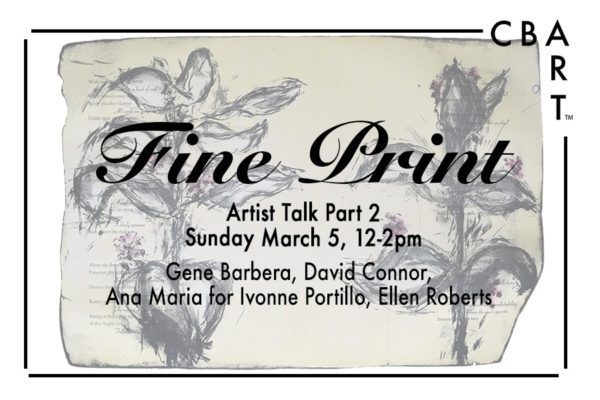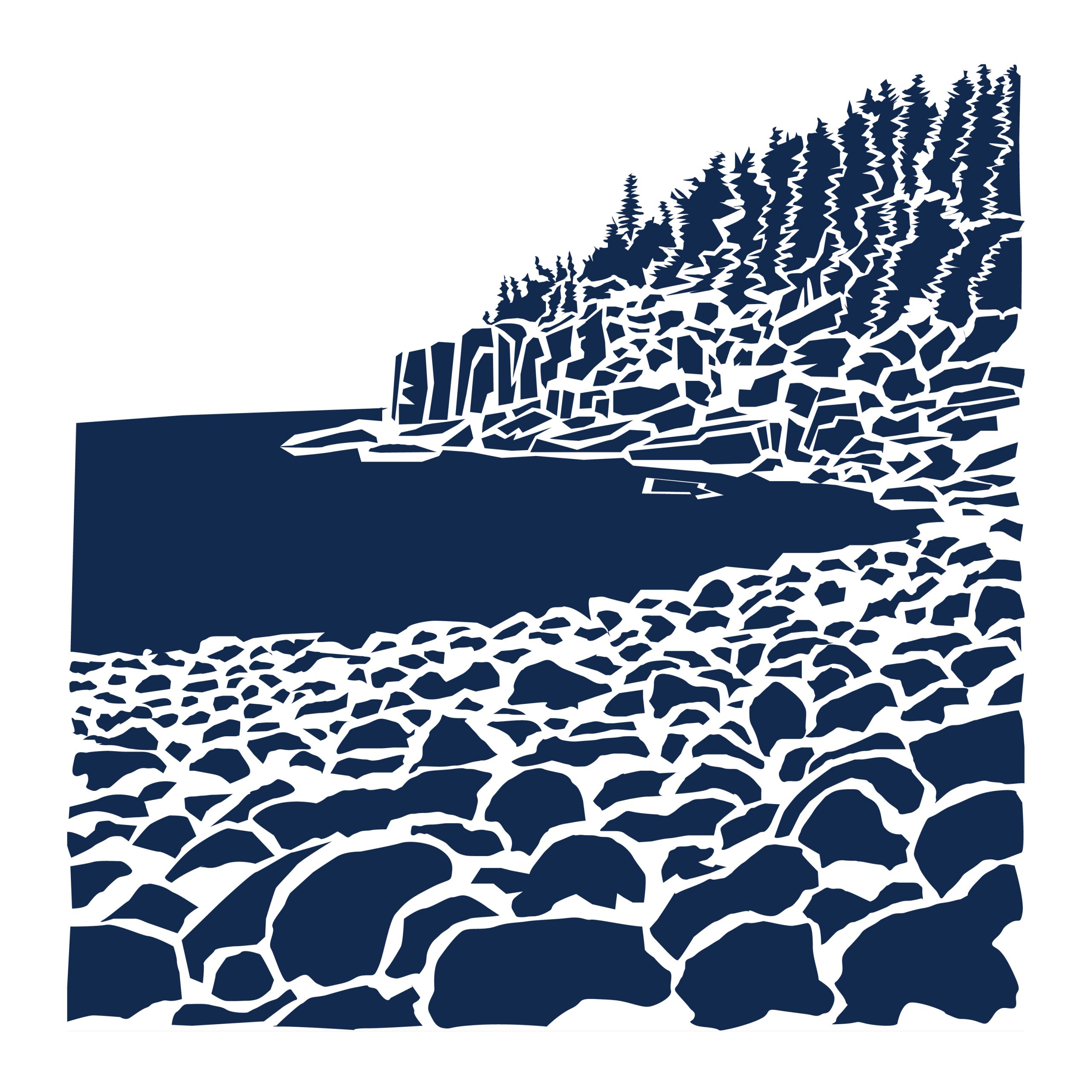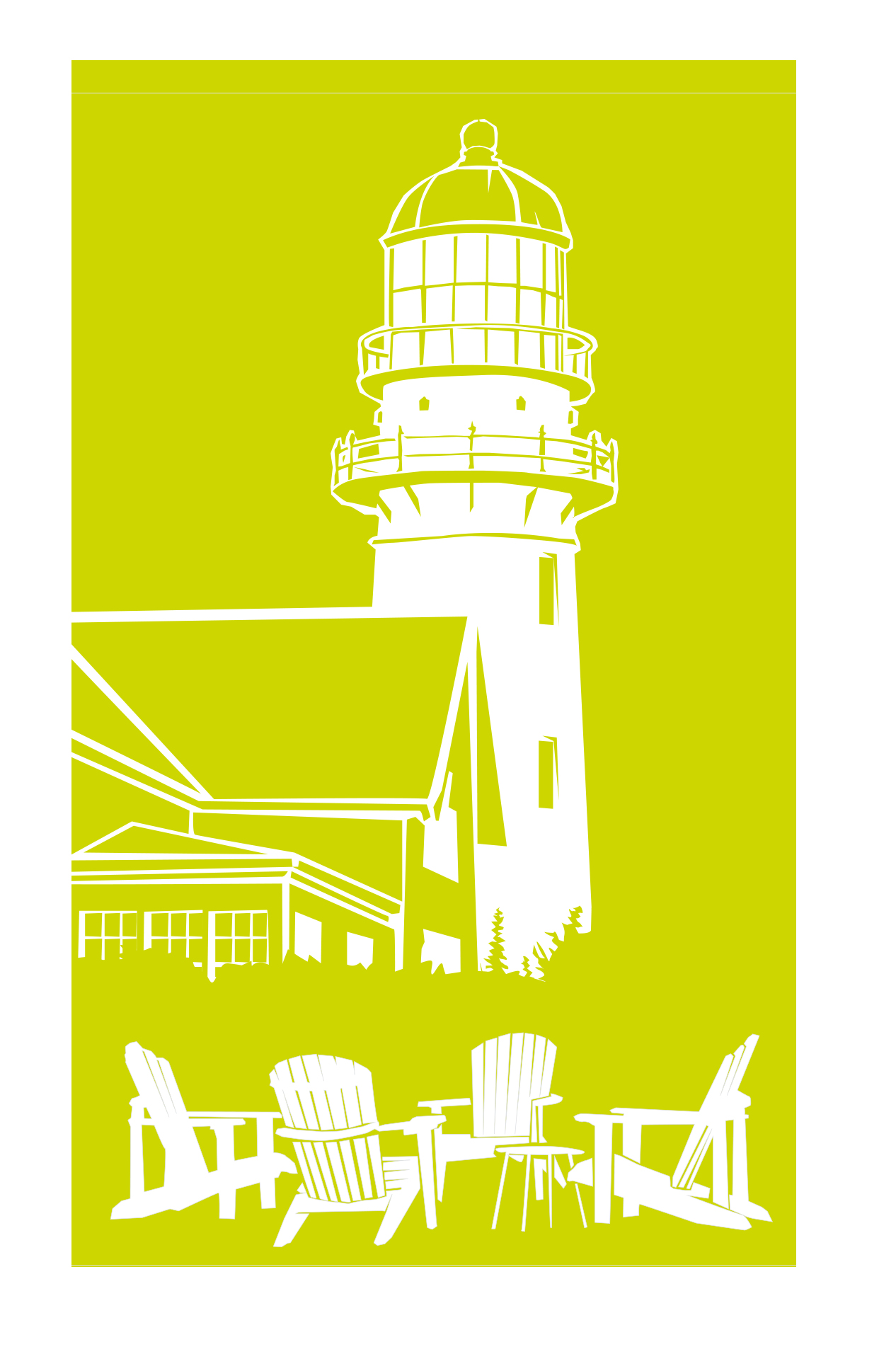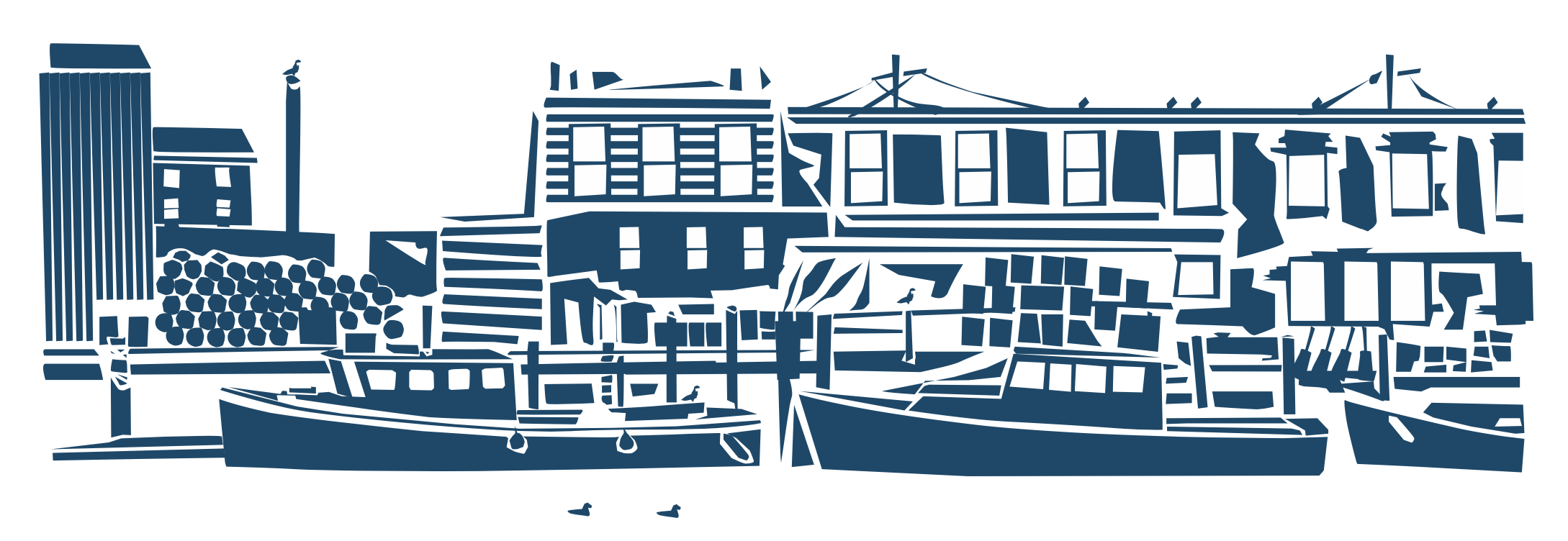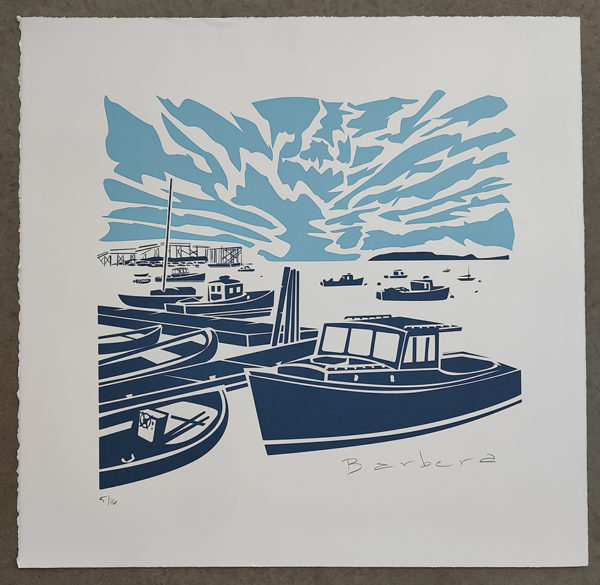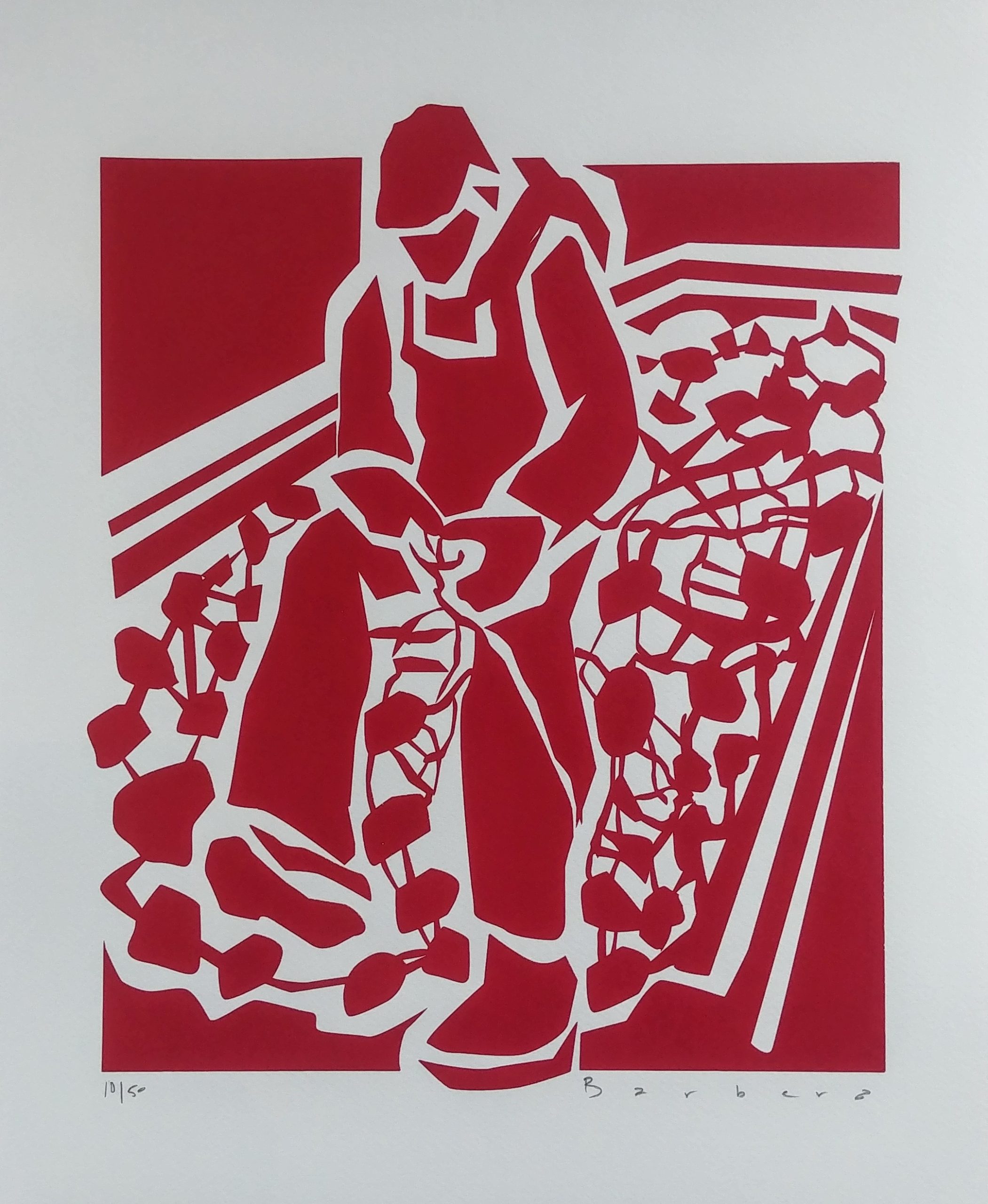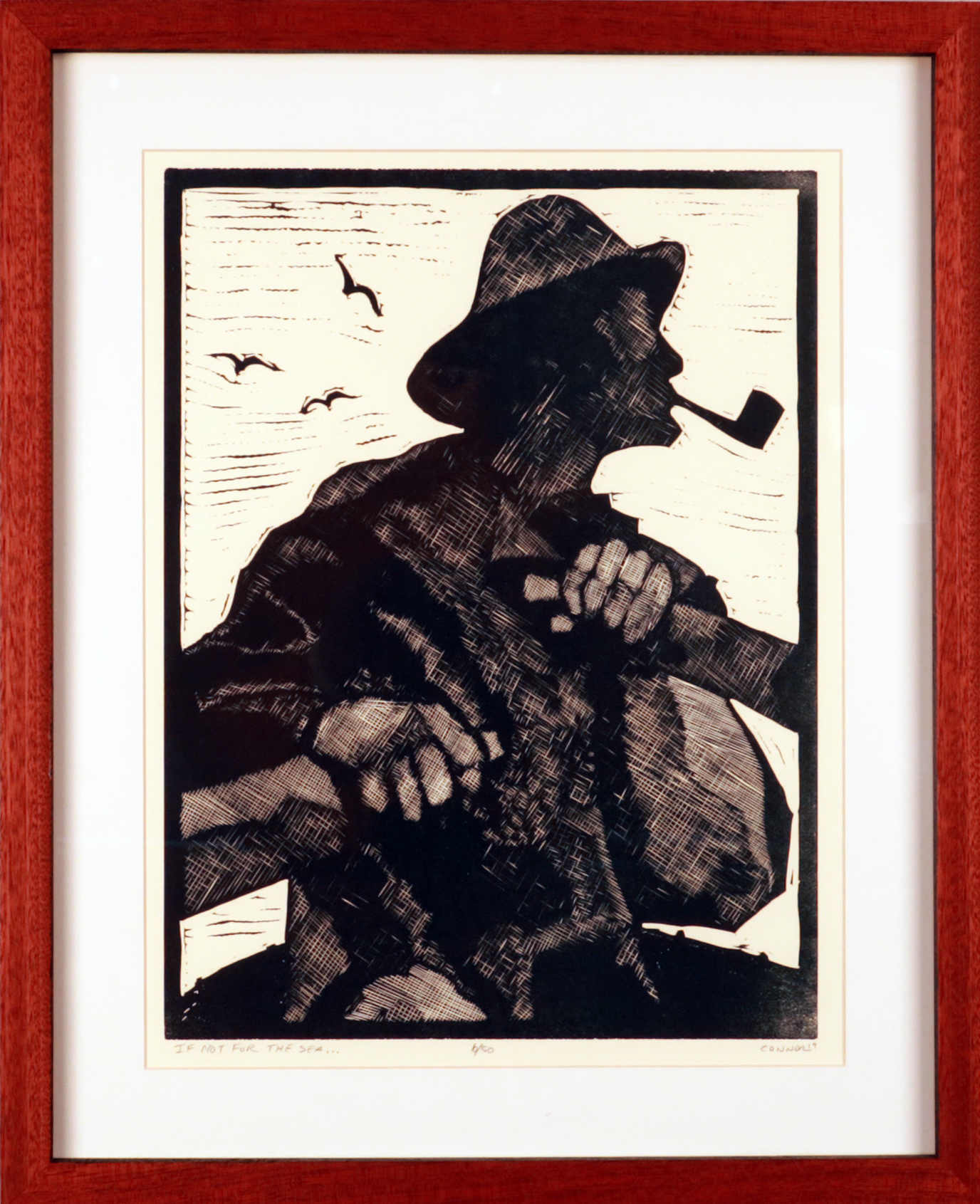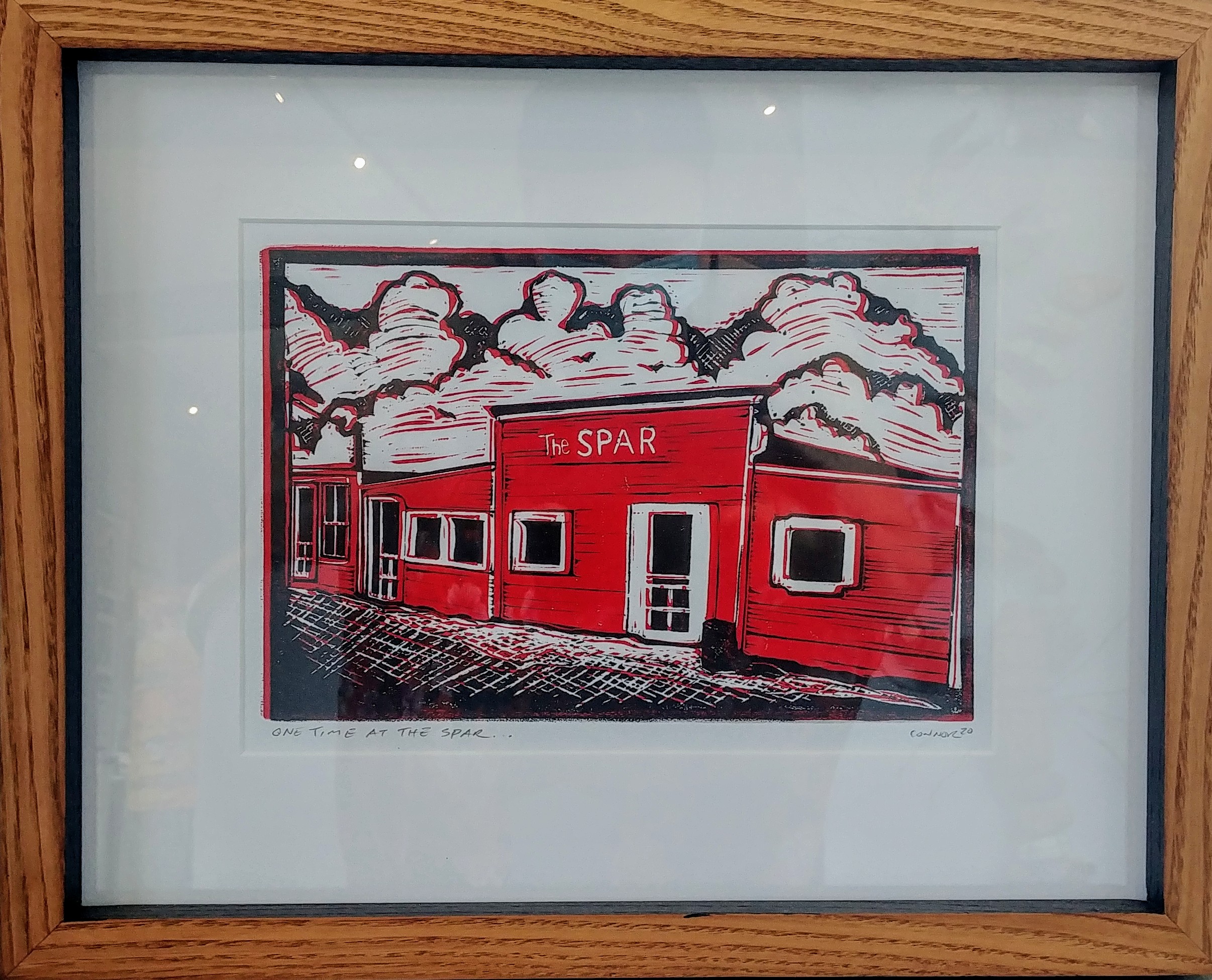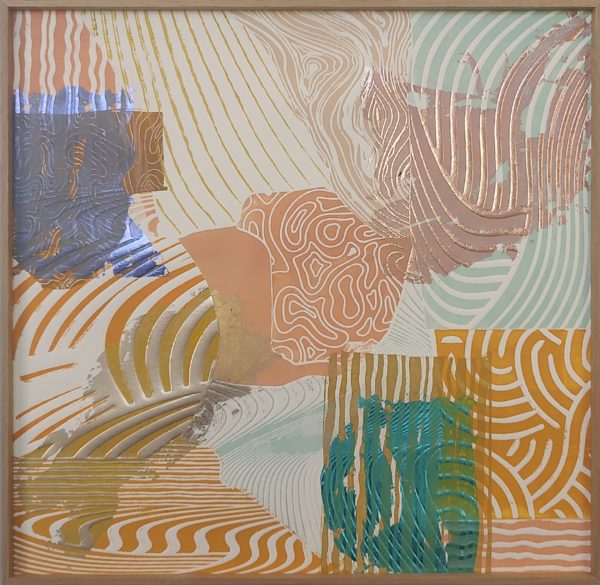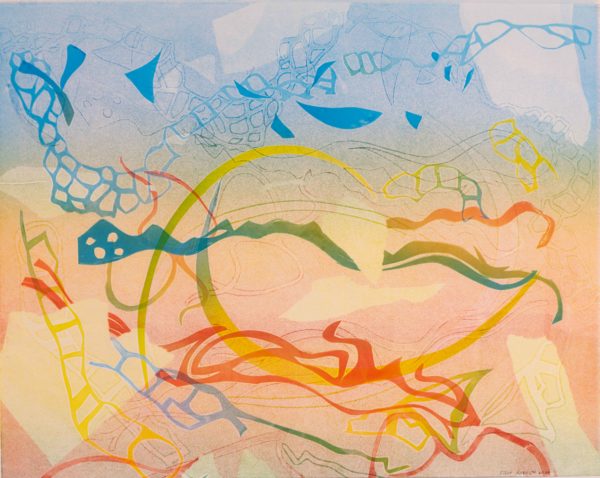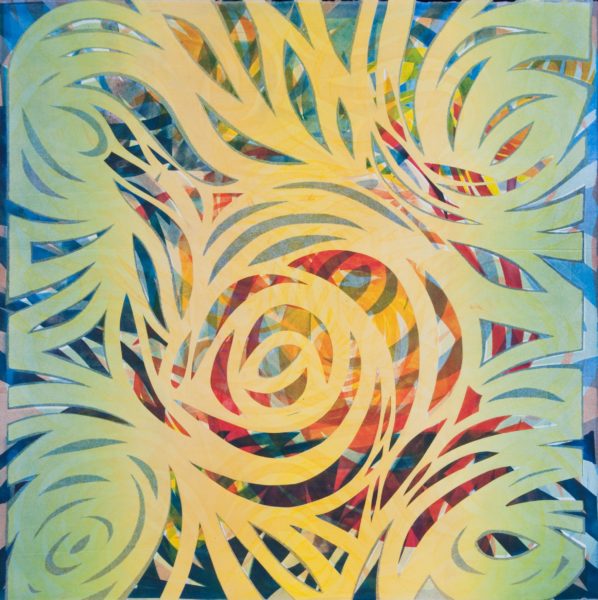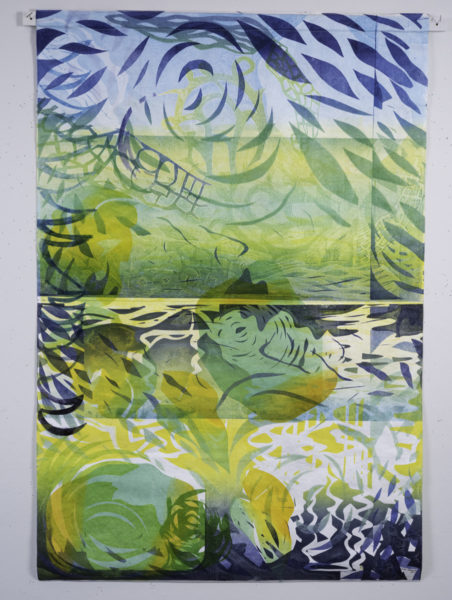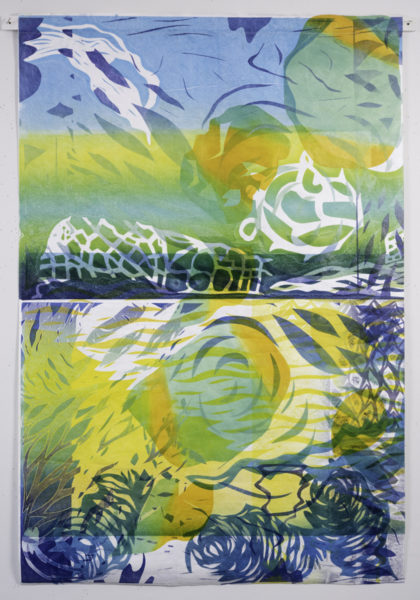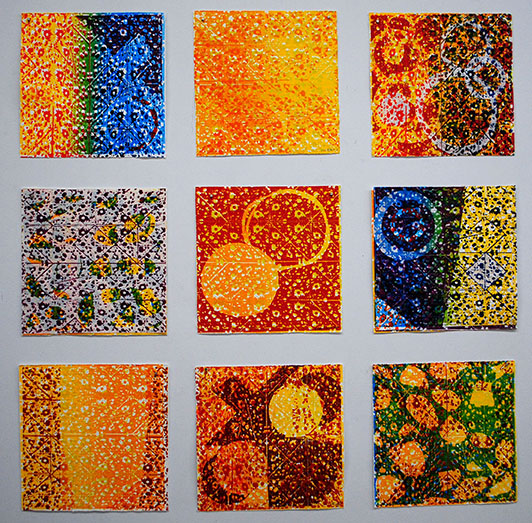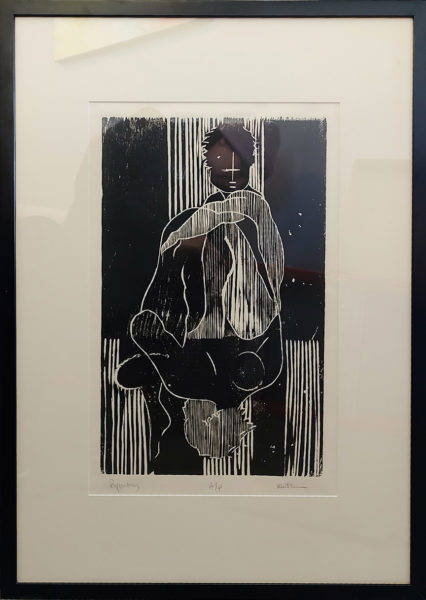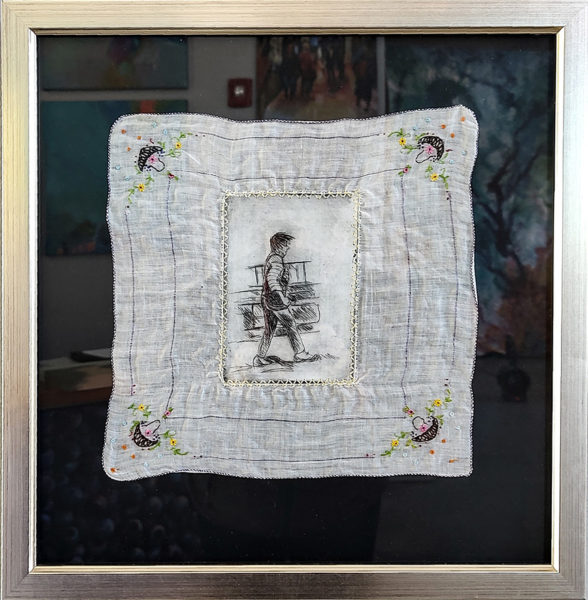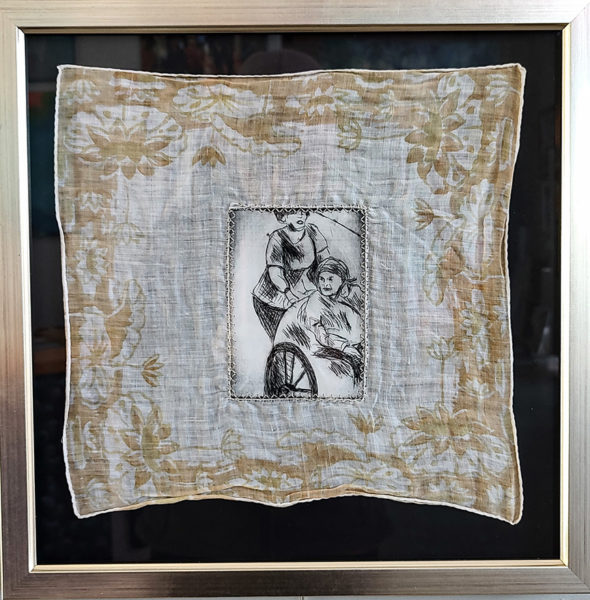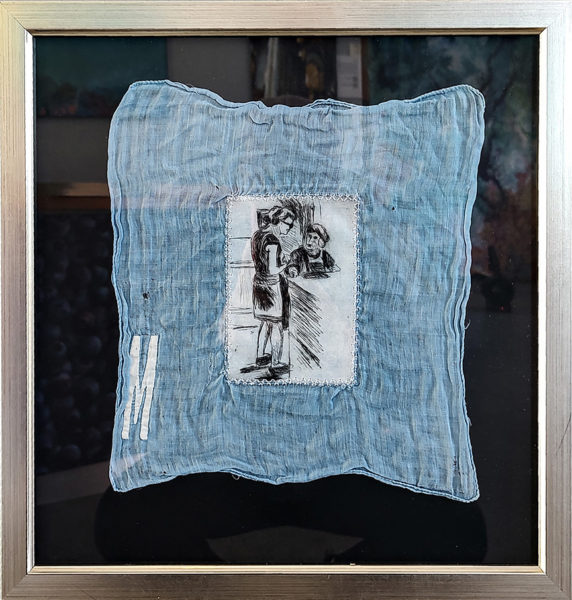Fine Print
Casco Bay Artisans presents Fine Print, an exhibition celebrating the multiple forms of printmaking by gallery artists. Fine Print intermingles the inconspicuous details and ethereal qualities that transform an object into art using etching, woodcut, stonecut, linocut, silkscreen, reduction, embossing, and solar printing. An interactive display invites collectors to get to know the tools of the trade with their own hands. Making marks on surfaces is inherent for communication. These works exemplify this universal experience to reveal the complexity of the human condition. This exhibition welcomes artists Greg Shattenberg and Ivonne Portillo to the CBA gallery.
Gene Barbera
To make one of his creations, Richard “Gene” Barbera tries to piece shapes together like a puzzle to form the image. Keeping the visual to a minimum, he learned keeping simple gets a better reaction. Let the viewer put the pieces together. He draws most of his inspiration from recognizable images from the coastal images and especially the Portland, ME area, where he grew up, and learned to practice art under visiting artist, such as Jamie Wyeth at the Portland School of Art (before MECA). Before finishing his degree in graphic design at the University of Hartford, he attended the University of Southern Maine where he was able to practice drawing and painting. Barbera moved to the New York City area after college, and designed large scale branding identities for companies such as Topps Card, Toys ‘R’ Us, and The National Hockey League. When he is not painting, or practicing art, Barbera travels to Madrid, Spain with his wife and two young children, where he manages to find more inspiration in his travels.
Available Work
David Connor
My name is David Connor and I have been making block prints for the last decade. I’m a woodworker at heart, but I’ve always desired to make art in a way that did not generate the same kind of noise or dust that working with wood often does.
The inspiration for my various prints comes primarily from wanting to capture images of things that are dear to me. I love Portland and many of my prints pay homage to some of my favorite places. Other influences include the ocean, animals and activities that bring joy to my life. Additionally, I love playing with the element of conflict and trying to capture that feeling with my art. To practice the craft, I initially challenged myself to complete the alphabet by carving various fruits and vegetables. After finishing, though, I sought to create work that was a little more engaging, and at times, a bit macabre.
I hand-make all of my picture frames as we’ll. All of the wood was scavenged, salvaged or reclaimed in one way or another. And while they are all roughly 10 x 10 inch frames, they are made from a variety of different species and are finished in as many different ways.
When I’m not creating art, I teach carpentry at a small alternative high school on the West End. I’m also a husband and father to an 11 and 13-year-old. I’m a veteran of the Coast Guard, an avid, year-round surfer of 25 years, a passionate gardener, a keeper of chickens and a general aesthetician who loves to take the old and create something new and different with it.
Available Work
Ivonne Portillo
Ivonne Portillo is a Colombian visual artist living in Barcelona. Her work celebrates the diversity of the peoples and landscapes of Latin America while emphasizing the vindication of the historical memory of indigenous peoples, many of whom structure their worldview around reciprocal relationships between us and what surrounds us. She transforms the shapes of the earth and its textures into carved and engraved topographies that she then prints on paper or fabric, using oil engraving paint and collage with metallized paper. She is inspired by land art to create abstractions of paths, forests, mountain ranges and bodies of water. The woodcut prints a trace representative of a diverse landscape, much like the Latin American lands which shelter 60% of the planet’s biodiversity. These lands are a natural mosaic that shelter infinite forms of human and non-human life.
Available Work
Ellen Roberts
Ellen Roberts is a mixed media artist who lives and works in Farmington, Maine. Roberts was born and raised in Rhode Island. From a very young age Ellen enjoyed making things with paper, fabric, string, yarn and clay. She was inspired by the landscape and began to make drawings from her life and natural environment.
Background
When Roberts was a teenager she wore a Milwaukee brace, (a steel and plastic corset that was strapped to her body for four years of her life from her neck to her pelvis). Swimming and showering were the only times she could remove the brace. Water brought fluidity to her life without the constraint of the brace and helped take the pressure of gravity off her spine.
During this time Roberts became more serious about her art. She decided to study art in college and began at the Rhode Island School of Design studying in Ceramics. Roberts had a fascination with color and found ceramic glazes were not a direct route for exploring color. She switched her focus to textiles focusing on weaving where she loved the complexity and textures of the materials. She studied at the University of Arts in Philadelphia, PA where she to learned how to weave structures and work with dye techniques such as ikat (a resist dye technique). After she received her MFA at Cranbrook Academy of Art.
As her life progressed she had a family and found working with fibers extremely labor intensive. For a while she made mixed media wall constructions out of fiber, paper, wood, and paint. Then she began making artist books. She thought she would like to learn to make editions through the process of printmaking. This was when her work started to take off.
Current Work
Early in 2022, I was recovering from an arm injury that resulted in my inability to work at the press. In the shortest days of winter, this limitation of movement felt like another lockdown. In retaliation, I started a daily practice of drawing and found myself focusing on the immediate details of my life –– the things that were accessible inside my home and directly outside my windows.
As the ground started to thaw, I ventured outside with a new capacity to incorporate nature’s chaos and structure. Back in the studio, this emerged as hand-cut stencils, arranged on an inked plexiglass plate, and then wound under pressure. Through layering, planning, and unpredictability the work was always evolving.
I found myself exploring and discovering new expressions. This created freedom
and yet required an uncontrollable tension. An iterative process with parts always in motion until they finally solidify into a complete form.
Today my work is primarily monotype prints forged from the evolution of techniques previously explored –– with hints from sculptural ceramics, dyed fibers, stitching, and woven wall pieces. In the mixing of oil-based inks, I select colors that weave together to create a complexity of structures, spaces, colors, and textures.
Available Work
Gail Waitkun
Gail Waitkun, a TBI Thriver, lives in Portland, Maine.Gail brings together more than twenty years of teaching experience infused with her former athleticism, and personal recovery experiences with brain injury. She is an Author, Artist, Educator, Life Strategist and TBI Expert. Her articles have been featured in the California Business Journal. She has recently published her third book.
Available Work
Joyce Ellen Weinstein
The works of Joyce Ellen Weinstein are concerned with the understanding of human relationships, beginning with ourselves and extending outward to include family, community, ethnicity, and nationality. Although at first glance the works of Joyce Ellen Weinstein appear disparate, after closer examination one can find her inspiration in the personal and emotional, as well as the interaction developed through self, family, and community – all of which are parts making up the whole of her unified body of work. Her works do not sentimentalize, but speak of the human measure and human condition. The works of Joyce Ellen Weinstein ask the universal question: “who am I and where am I going?”
Available Work
Aging and Resilience: Women of a Certain Age
by Joyce Ellen Weinstein
A lot has happened since my article “Aging and Mortality” was first published in 2020 in The Journal of the Print World. To quickly recap; the work, 3.5” x 5” dry point on plexiglass etchings, was inspired by an accident I had when I hurt my leg at the age of 79, and had to walk assisted by a cane. Never having had any disability shocked me into an awareness and empathy of others with physical challenges.
I really began to observe other older women who had mobility issues. Because I am a figurative artist and dedicated people watcher whose work is about life around me, I was totally moved and inspired and used this experience to create a new body of work about this life’s challenges. I took many iPhone photos, always keeping a respectful distance as I hobbled around the city and used my photos as reference.
Since the publication of my original article, some prints have been sold. I enjoyed an artist’s residency at Blue Mountain Center NY. I have two exhibitions planned, relocated from NYC to Westbrook, Maine, have been invited to write this recap of my original article, and have won a Maine Arts Commission grant to develop further this project. Receiving this grant was as much of a surprise to me as my leaving New York to run away from Covid. Never did I imagine leaving “the city.” But life has it’s surprises and now I can’t imagine living anywhere else but Maine … an amazingly artist -friendly place.
In ruminating over the experience and project, I have decided to alter the focus of my Ladies of a Certain Age. Originally they were to be printed in a set of four prints per image, each image gradually fading out into oblivion and/or becoming invisible as many old people are viewed, most especially women. But now I see these women in a completely different light; as resilient, enduring women who are tough and strong, who persist regardless of life’s challenges. I have learned to be resilient like my plexiglass dry-point ladies.
Because my women of a certain age are not to be dismissed, are not run of the mill, my presentation should take an unorthodox, a more experimental approach . Using the collection of antique handkerchiefs from my mother, (who died at the age of 99 about 15 years ago) and from my childhood, (when girls in elementary school in Brooklyn, where I grew up, had to bring a cloth handkerchief to school every day), I am dry mounting the images directly on hankies and embroidering a cross stitch around the image, suggesting a decorative frame like design. This refers to a by gone era … an era that these ladies may represent.
My first thought was to show them by individually hanging the hankies on a clothesline using miniature clothespins. But as I pictured this, I realized it was too cutesy and didn’t represent the dignity these women deserved. They need proper framing. Fortunately, I have a wonderful creative framer, and we are working together to create a presentation of the mounted hankies that are worthy of the ladies.
One of my favorite things to do is rummage through the old frames at Goodwill. I have discovered some amazing treasures that are perfect for framing the images that are not dry mounted on the hankies. I have found faux ornate silver, real pewter and metal frames that have decorative elements that also suggest timelessness. These frames can be either wall mounted or used on tabletops. One of these frames actually has a lace inset instead of mat board for mounting the image.
As I work through this project I also begin to see that some of the images tell me they want to be enlarged. I have completed two dry point on plexiglass images, one 10” x 8” and another 14”x 11” for example. I don’t think I am finished enlarging some and am not up to how to frame
them yet. Time will tell.
I am so loving how and where this project is taking me. It feels strong, enduring and forever evolving…just like my ladies.
Glossary of Terms
Sourced through Wikipedia
Screen printing is a printing technique where a mesh is used to transfer ink (or dye) onto a substrate, except in areas made impermeable to the ink by a blocking stencil. A blade or squeegee is moved across the screen to fill the open mesh apertures with ink, and a reverse stroke then causes the screen to touch the substrate momentarily along a line of contact. This causes the ink to wet the substrate and be pulled out of the mesh apertures as the screen springs back after the blade has passed. One color is printed at a time, so several screens can be used to produce a multi-coloured image or design.
Etching is traditionally the process of using strong acid or mordant to cut into the unprotected parts of a metal surface to create a design in intaglio (incised) in the metal.[1] In modern manufacturing, other chemicals may be used on other types of material. As a method of printmaking, it is, along with engraving, the most important technique for old master prints, and remains in wide use today. In a number of modern variants such as microfabrication etching and photochemical milling it is a crucial technique in much modern technology, including circuit boards.
Aquatint is an intaglio printmaking technique, a variant of etching that produces areas of tone rather than lines. For this reason it has mostly been used in conjunction with etching, to give both lines and shaded tone.[1] It has also been used historically to print in color, both by printing with multiple plates in different colors, and by making monochrome prints that were then hand-coloured with watercolor.
Linocut, also known as lino print, lino printing or linoleum art, is a printmaking technique, a variant of woodcut in which a sheet of linoleum (sometimes mounted on a wooden block) is used for a relief surface. A design is cut into the linoleum surface with a sharp knife, V-shaped chisel or gouge, with the raised (uncarved) areas representing a reversal (mirror image) of the parts to show printed. The linoleum sheet is inked with a roller (called a brayer), and then impressed onto paper or fabric. The actual printing can be done by hand or with a printing press.
Woodblock printing or block printing is a technique for printing text, images or patterns used widely throughout East Asia and originating in China in antiquity as a method of printing on textiles and later paper. Each page or image is created by carving a wooden block to leave only some areas and lines at the original level; it is these that are inked and show in the print, in a relief printing process. Carving the blocks is skilled and laborious work, but a large number of impressions can then be printed.
Embossing and debossing are the processes of creating either raised or recessed relief images and designs in paper and other materials. An embossed pattern is raised against the background, while a debossed pattern is sunken into the surface of the material but might protrude somewhat on the reverse side.
Often used in combination with foil stamping, embossing alters the surface of paper stock or other substrates by providing a three-dimensional or raised effect on selected areas. The procedure requires the use of two dies: one that is raised and one that is recessed. The dies fit into each other so that when the paper is pressed between them, the raised die forces the stock into the recessed die and creates the embossed impression. A specific level of pressure is applied to the dies in order to squeeze the fibers of the paper, which results in a permanently raised area in the paper. When the dies are produced, a die maker engraves the desired image into several metal plates, which are the embossing dies for use on an embossing press. A thorough understanding of the process will enable a more successful result. Generally, embossing is the process most often employed to attract attention or convey a high quality textural contrast in relation to the surrounding area of the paper stock.



